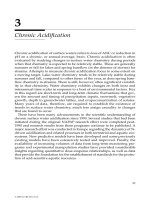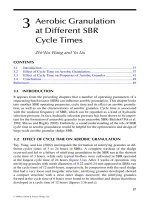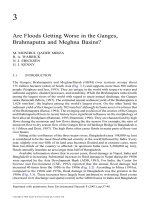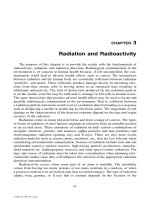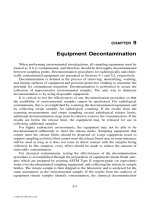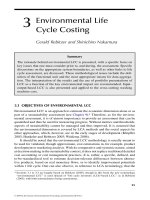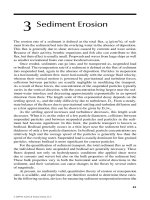CONCRETE IN HOT ENVIRONMENTS - CHAPTER 3 potx
Bạn đang xem bản rút gọn của tài liệu. Xem và tải ngay bản đầy đủ của tài liệu tại đây (437.14 KB, 28 trang )
Chapter 3
Mineral Admixtures and Blended
Cements
3.1. MINERAL ADMIXTURES
Admixtures are, by definition, ‘a material other than water, aggregates,
hydraulic cement and fibre reinforcement used as an ingredient of concrete or
mortar and added to the batch immediately before or during mixing’ (ASTM
C125). Such a definition satisfies a wide range of materials, but a
comprehensive discussion of all types involved is not attempted here.
Accordingly, the following presentation is limited to the so-called ‘mineral
admixtures’ whereas another group of admixtures, known as ‘chemical
admixtures’ is discussed in section 4.3.2. The preceding reference to mineral
admixtures is not always accepted and the term ‘additions’, rather than
admixtures, has been suggested [3.1]. Moreover, this term of mineral additions
was defined to include materials which are blended or interground with
Portland cement, in quantities exceeding 5% by weight of the cement, and not
only those which are added directly to the concrete before or during mixing.
On the other hand, the term ‘addition’ was defined as ‘a material that is
interground or blended in limited amounts into hydraulic cement as a
“processing addition” to aid manufacturing and handling of the cement, or as
a “functional addition” to modify the use properties of the finished product’
(ASTM C219). That is, the latter is quite a different definition which covers
a different type of materials. Hence, in order to avoid possible
misunderstanding, the term ‘mineral admixtures’, as defined by ASTM C125–
88, is used hereafter.
Copyright 1993 E & FN Spon
Generally, mineral admixtures are finely divided solids which are added to
the concrete mix in comparatively large amounts (i.e. exceeding 15% by
weight of the cement) mainly in order to improve the workability of the
fresh concrete and its durability, and sometimes also its strength, in the
hardened state. It will be seen later (section 3.2) that these materials are also
used as partial replacement of Portland cement in the production of ‘blended
cements’.
Mineral admixtures may be subdivided into low-activity, pozzolanic and
cementitious admixtures.
3.1.1. Low-Activity Admixtures
This type of admixture, sometimes referred to as ‘inert fillers’, hardly reacts with
water or cement and its effect is, therefore, essentially of a physical nature.
Finely ground limestone or dolomite, for example, constitute such admixtures,
and their use may be beneficial in improving the workability and the
cohesiveness of concrete mixes which are deficient in fines. The use of low-
activity admixtures is practised only to a very limited extent, and is of no
particular advantage in a hot environment. Hence, this type of admixture is not
further discussed.
3.1.2. Pozzolanic Admixtures
3.1.2.1. Pozzolanic Activity
Pozzolanic admixtures, or ‘pozzolans’, contain reactive silica (SiO
2
), and
sometimes also reactive alumina (Al
2
O
3
), which, in the presence of water, react
with lime (Ca(OH)
2
) and give a gel of calcium silicate hydrate (CSH gel) similar
to that produced by the hydration of Portland cement. Accordingly, pozzolans
are ‘silicious or silicious and aluminous materials which, in themselves, possess
little or no cementitious value but will, in a finely divided form and in the
presence of moisture, chemically react with calcium hydroxide at ordinary
temperatures to form compounds possessing cementitious properties’ (ASTM
C219). Such material are said to exhibit ‘pozzolanic activity’ and the chemical
reactions involved are known as ‘pozzolanic reactions’.
In the hydration of Portland cement (see section 2.3), a considerable
amount of calcium hydroxide is produced. Hence, in mixtures made of a
pozzolan and Portland cement, a pozzolanic reaction will take place due to the
availability of lime. This availability of lime facilitates the replacement of
Copyright 1993 E & FN Spon
some part of Portland cement by pozzolans and explains why such an
admixture can be used to produce pozzolan-based blended cements.
3.1.2.2. Classification
Generally, the pozzolans may be subdivided into natural and by-product
materials. The former are naturally occurring materials, and their processing
is usually limited to crushing, grinding and sieving. Such materials include
volcanic ashes and lava deposits (e.g. volcanic glasses and volcanic tuffs) and
are known, accordingly, as ‘natural pozzolans’. Another type of natural
pozzolan is diatomaceous earth, i.e. an earth which is mainly composed of the
silicious skeletons of diatoms deposited from either fresh or sea water.
Naturally occurring clays and shales do not exhibit pozzolanic properties.
However, when heat treated in the temperature range 600–900°C, such
materials become pozzolanic and are referred to as ‘burnt’ or ‘calcined
pozzolans’. Strictly speaking, the latter are actually ‘artificial pozzolans’, but
usually they are grouped together with natural pozzolans (ASTM C618).
As mentioned earlier, another group of pozzolans are by-product materials
of some industrial process. The most common materials in this group are
pulverised fly-ash (PFA) and condensed silica fume (CSF).
3.1.2.2.1. Pulverised fly-ash (PFA). Coal contains some impurities such as
clays, quartz, etc. which, during the coal combustion, are fused and
subsequently solidify to glassy spherical particles. Most of the particles are
carried away by the flue gas stream and later are collected by electrostatic
precipitators. Hence, as mentioned earlier, this part of the ash is known as fly-
ash in the US, and pulverised fly-ash in the UK. The remaining part of the ash
agglomerates to give what is known as ‘bottom ash’.
Generally, fly-ash consists mostly of silicate glass containing mainly
calcium, aluminium and alkalis. The exact composition, and the resulting
properties of fly-ash, may vary considerably, and in this respect the CaO
content is very important. Accordingly, fly-ashes are subdivided into two
groups: low-calcium fly-ashes (CaO content less than 10%), and high-calcium
fly-ashes (CaO content greater than 10%, and usually between 15 and 35%).
This difference in CaO content is reflected in the properties of the fly-ashes.
Whereas, for example, high-calcium fly-ashes are usually both pozzolanic and
cementitious, low-calcium fly-ashes are only pozzolanic.
ASTM C618 classifies fly-ashes in accordance with their origin, namely,
class F refers to fly-ashes which are produced from burning anthracite or
Copyright 1993 E & FN Spon
bituminous coal, and class C refers to fly-ashes which are produced from
burning lignite or sub-bituminous coal (Table 3.1). Usually the CaO content of
class C fly-ashes is greater than 10%, and that of class F is lower. That is, the
classification into low-calcium and high-calcium fly-ashes is essentially
identical to that of ASTM C618 into F and C classes.
In addition to the CaO content, the properties of fly-ashes are determined, to
a great extent, by their particle sizes and coal content. Generally, the finer the
particles the greater the rate of the pozzolanic reaction, and the resulting
development of strength. That is, coarser particles are not desirable explaining, in
turn, the maximum imposed by the standards on the amount of fly-ash retained
Table 3.1. Classification and Properties of Fly-Ash and Raw or Calcined
Natural Pozzolan for Use as a Mineral Admixture in Portland Cement Concrete
in Accordance with ASTM Standard C618–89a
a
The use of class F pozzolan containig up to 12% loss of ignition may be allowed if either
acceptable performance records or laboratory test results are made available.
Copyright 1993 E & FN Spon
on a No. 325 sieve (45 µ m). In fact, particle size, as measured by the latter
parameter, is used to classify fly-ashes in the British Standards (Table 3.2).
The coal content is measured by the loss of ignition. The presence of coal
in the fly-ash is not desirable, mainly because it increases the water demand
due to its great specific surface area. That is, the higher the coal content, the
greater the amount of water which is required to impart a certain consistency
to otherwise the same concrete mix. An increased amount of water adversely
affects concrete properties and, thereby, explains the maximum imposed by
the standards on water requirement, on the one hand, and the loss of ignition,
on the other (Tables 3.1 and 3.2).
3.1.2.2.2. Condensed silica fume (CSF). CSF or, simply, microsilica, or silica
fume, is an extremely fine by-product of the silicon metal and the ferrosilicon
alloy industries, consisting mainly of amorphous silica (SiO
2
) particles.
The silicon metal is produced by reducing quartz by coal at the temperature
of about 2000°C. The reduction of the quartz is not complete and some SiO
gas is produced. Part of this gas escapes into the air, is oxidised to SiO
2,
and
the latter is condensed to very small and spherical silica particles. Hence, the
reference to CSF [3.3].
The most notable properties of microsilica are its very small particle size and
high silica content. The average diameter of the microsilica particles is about 0·1
µm, resulting in a very high specific surface area of some 20 000 m
2
/kg. That
is, the size of the microsilica particles is two orders of magnitude smaller than
Table 3.2. Classification and Properties of Fly-Ash for use as a Mineral
Admixture in Portland Cement Concrete in Accordance with British Standard
BS 3892, Part 1, 1982 and Part 2, 1984
Copyright 1993 E & FN Spon
the size of the cement particles (average size 10 µ m) or of fly-ash particles (Fig.
3.1). The silica content depends on the type of metal which is produced and
varies, accordingly, from 84 to 98%.
The very high specific surface area, combined with the high silica content,
accelerate the pozzolanic reactions, and thereby accelerate strength
development (see section 3.1.2.3.4). In addition, the minute size of the silica
fume particles produces a filler effect in the cement paste. This filler effect is
schematically described in Fig. 3.2. On mixing with water, and for the same
water to solids ratio, the initial porosity (i.e. the fractional volume occupied
by the water) is the same in both systems considered. The very small silica
fume particles, however, readily fill the spaces between the much coarser
cement grains and, thereby, reduce the spacing between the solids. Hence, on
subsequent hydration, the resulting capillary pores in the silica-fume-
containing paste are much finer than the pores in the neat cement paste. That
is, a more refined capillary pore system is brought about by incorporating
silica fume in concrete mixes. Figure 3.3 presents experimental data which
compare pore-size distributions in neat Portland cement and Portland cement
plus silica fume pastes. It is clearly evident that the latter paste is characterised
by a much finer pore system. This refinement in the pore system has important
practical implications. It will be seen later that the lower permeability of silica-
fume-containing concrete, and its associated improved durability, is
attributable, partly at least, to the finer pore system which is brought about
by the use of silica fume.
Fig. 3.1. Comparison of particle size distributions of Portland cement, fly-ash, and
CSF. (Adapted from Ref. 3.2.)
Copyright 1993 E & FN Spon
The very high specific surface area of silica fume increases considerably the
water demand of mortars and concretes, and this increase is greater the higher
the silica fume addition (Fig. 3.4). In order to avoid such an increase, and its
associated adverse effect on concrete properties, silica fume is always used
with a water reducer, usually a high-range water reducer (see section 4.3.2).
The specific water-reducing effect of such admixtures depends on many factors
but it is usually more than enough to offset the increased water demand
brought about by the use of silica fume.
3.1.2.3. Effect on Cement and Concrete Properties
The effect of pozzolans on the properties of Portland cement and concrete
depends on the properties of the specific materials involved. Noting that even
pozzolans of the same type may vary considerably, a general discussion of
their effect is necessarily of a qualitative rather than of a quantitative nature.
Accordingly, this is the nature of the following discussion whereas, in practice,
the specific properties of the pozzolan in question must be considered.
3.1.2.3.1. Heat of hydration. Similarly to the hydration of Portland cements,
the pozzolanic reactions result in the liberation of heat. The heat liberation
Fig. 3.2. Refinement of the pore-system in a cement paste due to the filler effect
of silica fume.
Copyright 1993 E & FN Spon
Fig. 3.3. Effect of replacing 30% of Portland cement (by absolute volume), with
silica fume, or fly-ash, on pore-size distribution of the cement paste at the ages
of 28 and 90 days. (Adapted from Ref. 3.4.)
Fig. 3.4. Effect of silica fume content on water demand of concrete without a
water-reducing agent. (Adapted from Ref. 3.5.)
Copyright 1993 E & FN Spon
due to the latter reactions is less than that due to the hydration of Portland
cement, and the rate of the pozzolanic reactions is lower than that of the
hydration of Portland cement. Hence, replacing part of the Portland cement
with a pozzolan would result in a cement with a lower heat of hydration, and
the reduction in the heat of hydration would increase with the increase in the
percentage of the Portland cement replaced by the pozzolan. The data
presented in Fig. 3.5, which relate to an Italian natural pozzolan, clearly
confirm these expected effects of pozzolanic admixtures on the heat of
hydration of the cement. These effects are further confirmed by the data of
Fig. 3.6, in which Portland cement was partly replaced by fly-ash (part A) and
CSF (part B). Accordingly, it may be generally concluded that the partial
replacement of Portland cement with a pozzolanic admixture results in a
cement of a lower heat of hydration, and that such a cement may be used in
lieu of low-heat Portland cement (see section 1.5.2).
The preceding conclusion with respect to the effect of CSF must be
treated with some reservation. The very high specific surface area of the
silica fume increases the rate of the pozzolanic reactions and thereby
increases the rate of the resulting heat evolution. Hence, the heat of
hydration of a cement containing silica fume may be higher than, say, its
fly-ash-containing counterpart, and, perhaps, as high as, or even higher
than, the heat of hydration of Portland cement. This expected effect is
confirmed by the data of Fig. 3.7, but not by those of Fig. 3.6 where the
silica fume was found to reduce the heat of hydration of the cement and,
Fig. 3.5. Effect of partial replacement of Portland cement with an Italian natural
pozzolan on the heat of hydration of the cement. (Adapted from Ref. 3.6.)
Copyright 1993 E & FN Spon
in this respect, the effects of both the silica fume and the fly-ash were
essentially the same.
3.1.2.3.2. Microstructure. Replacing Portland cement with silica fume results
in a finer pore system (Fig. 3.3). This effect of silica fume is attributable,
partly at least, to the filler effect of the very small silica fume particles (Fig.
3.2). Such an effect, however, is not expected in other pozzolans which are
characterised by a particle-size similar to that of Portland cement.
The effect of replacing Portland cement with fly-ash on pore size
distribution is also presented in Fig. 3.3. Accordingly, it can be seen that, at
Fig. 3.6. Effect of partial replacement of Portland cement with (A) fly-ash, and (B)
CSF, on the heat of hydration of the cement (cement pastes, water to solids
ratio=0·5). (Adapted from Ref. 3.7).
Fig. 3.7. Effect of partial replace-
ment of Portland cement with con-
densed silica fume on the heat of
hydration of the cement. (Adapted
from Ref. 3.8.)
Copyright 1993 E & FN Spon
the age of 28 days, the fly-ash paste exhibited a somewhat greater porosity
than its neat Portland cement counterpart, but the pore-size distribution of the
two pastes was essentially the same. At the age of 90 days, although the
porosity of the fly-ash paste remained higher than that of the neat Portland
cement paste, its pore system became finer. Hence, it is usually accepted that
the use of fly-ash is associated with a finer pore system, but not necessarily
with a lower porosity. It may be realised that the finer pore system is reflected
in lower permeability, provided the concrete is adequately cured. This aspect,
however, is discussed later in the text (see section 9.2).
3.1.2.3.3. Calcium Hydroxide Content and pH of Pore Water. The consumption
of calcium hydroxide due to the pozzolanic reactions is of practical importance
when possible corrosion of the reinforcing steel of the concrete is considered.
The presence of calcium hydroxide imparts to the pore water of the cement
paste a high pH value of about 12–5, and such a high alkalinity protects the
reinforcement against corrosion. This protection is lost, however, once the pH
of the pore water drops below, say, 9, and it may be questioned if such a drop
occurs due to the consumption of the calcium hydroxide by the pozzolanic
reactions. That is, if this is really the case, the use of pozzolanic admixtures
should be avoided, or even prohibited altogether, in reinforced concrete.
The effect of pozzolans and of other admixtures on possible corrosion of
the reinforcing steel in concrete is discussed in some detail in Chapter 10. At
this stage, however, it is enough to point out that the pozzolanic reactions
lower only slightly the pH value of the pore water. This effect is demonstrated,
for example, in Fig. 3.8 which relates to test data in which 15, 25 and 35%
of Portland cement were replaced by two types of class F fly-ash. It can be seen
that at the age of 150 days, and when fly-ash replaced 35% of the cement, the
Ca(OH)
2
content was reduced by a factor greater than 2, whereas the pH
value of the pore water dropped only slightly, i.e. from 12·97 to 12·72. Such
a slight reduction was also reported by others when 30% of the cement was
replaced by fly-ash [3.10].
A more significant reduction in the pH level was observed when silica fume
was used to replace the cement, and particularly when the silica fume content
was 30% (Fig. 3.9). However, when considering the more practical content of
10%, the reduction of the pH level remains insignificant.
3.1.2.3.4. Strength Development. The development of strength with time is
brought about by the hydration of the cement because, as the hydration
proceeds, the porosity of the cement paste decreases (see section 2.4). Similarly,
Copyright 1993 E & FN Spon
the strength increases as the pozzolanic reactions proceed. The pozzolanic
reactions are usually slower than the hydration of Portland cement and,
consequently, the strength development of pozzolan-Portland cement blends is
slower than the strength development of their unblended counterparts. Indeed,
with the exception of blends in which silica fume is used, the early strength
(i.e. for the first few weeks or even longer) of concretes made with a pozzolan-
containing cement is lower than the strength of concretes made with
unblended ordinary Portland cement (Fig. 3.10), and the higher the pozzolan
content the greater the reduction in early strength [3.11, 3.12].
Although the preceding effects of pozzolans on early-age strength, have
Fig. 3.8. Effect of fly-ash content on (A) Ca(OH)
2
content, and (B) pH value of the
pore water, in Portland cement-fly-ash pastes at the age of 150 days. (Adapted
from Ref. 3.9.)
Fig. 3.9. Effect of silica fume
content on the pH value of the
pore water of cement pastes
(W/(C+SF)=0·50). (Adapted
from Ref. 3.11.)
Copyright 1993 E & FN Spon
been widely observed and recognised, there exists some conflicting data with
respect to their effect on later age strength. The data of Fig. 3.10, for example,
indicate that replacing 30% of Portland cement by fly-ash produces a higher
later age strength than that produced by the unblended cement, but not when
replaced by the same amount of calcined diatomaceous shale. Yet, other data
clearly indicate that the use of fly-ash is associated with both lower early and
later age strengths (Fig. 3.11). These apparently contradictory data may be
attributed to possible differences in curing conditions and the type of fly-ash
involved. It seems that in practice, however, unless data are available to the
contrary, it should be assumed that pozzolan-Portland cement blends produce
Fig. 3.10. Effect of replacing 30% of Portland cement by fly-ash, or by calcined
diatomaceous earth, on concrete strength. (Adapted from Ref. 3.13.)
Fig. 3.11. Effect of replacing Portland cement by different amounts of fly-ash on
concrete strength (OPC+FA=320 kg/m
3
, W/(C+FA)=0·66, 7 days moist curing).
(Taken from the data of Ref. 3.14.)
Copyright 1993 E & FN Spon
lower strengths than their unblended counterparts, and particularly when the
concrete is not cured for an extended period of time.
When silica fume is used to replace Portland, due to its high reactivity,
concrete strength development is rather different from that observed when
other pozzolans are used (Fig. 3.12). That is, the early-age strength is
greater than that of unblended Portland cements, and the later-age strength
is not only higher, but increases with the increase in the silica fume content
as well. It may be noted that when other pozzolanic admixtures are used,
a decrease in later age strength is observed when the admixture content is
increased.
3.1.2.3.5. Other Properties. The preceding discussion deals with the effects of
pozzolanic admixtures on some, but not on all, concrete properties. The
admixtures effect on the remaining properties of concrete, such as volume
changes and durability, requires some discussion of the properties in question
before the effects of admixtures can be adequately treated. Hence, such
treatment is presented in the relevant chapters.
3.1.3. Cementitious Admixtures
This type of admixture possesses hydraulic properties of its own and includes
such materials as natural cements and hydraulic lime. However, by far the
most common one is blast-furnace slag, or rather ground granulated blast-
furnace slag. Hence, only this type of material is discussed hereafter.
Fig. 3.12. Effect of replacing Portland cement by different amounts of silica
fume on compressive strength of concrete. (Adapted from Ref. 3.15.)
Copyright 1993 E & FN Spon
3.1.3.1. Blast-Furnace Slag
Blast-furnace is a by-product of the pig iron industry, in which iron ores,
mainly oxides of iron, are reduced to metallic iron.
The iron ores contain a certain amount of impurities, which are mainly SiO
2
and Al
2
O
3
. In order to separate these impurities from the melted iron, a certain
amount of lime is added to the charge. The lime combines with the silica and
the alumina, and the resulting molten slag, being much lighter than the molten
iron, floats on top of the latter and is subsequently removed.
In order to give the slag hydraulic properties, it must be cooled rapidly,
usually by quenching the liquid slag by water. In this process the molten slag,
before being immersed in water, is broken up by water jets. Consequently, a
slag having sand-size particles is produced, and is known, accordingly, as
‘granulated’ blast-furnace slag. Another, less common method, involves
quenching by air with a limited amount of water. In this method, the slag is
produced in the form of pellets and is known, accordingly, as ‘pelletised’ blast-
furnace slag.
After being dried, the slag is ground together with Portland cement clinker
to produce Portland blast-furnace slag cements (see section 3.2). Alternatively,
it may be ground separately and the latter cements are produced by blending
the pulverised slag with Portland cement. The use of slag on the building site
as an admixture is, however, rather limited. Slag particles greater than 45 µ m
are barely reactive. Hence, the limitation imposed by ASTM C989, for
example, on the amount of slag particles retained on the 45 µ m sieve.
Blast-furnace slag is composed mainly of calcium, magnesium and alumina-
silicates which are mostly, due to the rapid cooling of the slag, non-crystalline
and glassy. In addition to particle size, both glass composition and content
affect the reactivity of the slag. Usually a higher glass content, a higher
combined content of lime (CaO), magnesia (MgO) and Al
2
O
3
and a lower SiO
2
content, are associated with a higher reactivity. Moreover, the degree of the
disorder of the glass structure affects significantly the reactivity of the slag
and, generally speaking, a more disordered structure results in a more reactive
slag.
The preceding effects of composition and glass content on the reactivity of
the slag are reflected in BS 6699, 1986 by a minimum imposed on the contents
of pure glass and glassy particles, the latter being particles which include both
glass and crystalline material (Table 3.3). Similarly, the limitation of the
composition is reflected in imposing a minimum on a so-called ‘chemical
modulus’ which is defined by the following ratio:
Copyright 1993 E & FN Spon
in which the bracketed formulae refer to the percentage of the particular oxide
by mass in the slag. In accordance with BS 6699, 1986 the chemical modulus
must be not less than one and the CaO to SiO
2
ratio not more than 1·4 (Table
3.3). No such limitations are imposed by the relevant ASTM Standard C989
(Table 3.4), which specifies the required reactivity of the slag more directly by
a so-called ‘slag activity index’, which is defined by the following ratio:
Slag activity index (%)=(SP/P)×100
in which SP is the average compressive strength of a slag-cement reference
mortar, i.e. a mortar prepared from a blend made of 50% slag and 50%
Portland cement by mass; and P is the average compressive strength of
otherwise the same mortar made of the unblended Portland cement.
(3.2)
(3.1)
Table 3.3. Required Properties of Ground Granulated Blast-Furnace Slag for Use
with Portland Cement in Accordance with BS 6699, 1986
Copyright 1993 E & FN Spon
Granulated blast-furnace slag is actually a latent hydraulic binder and, in
the absence of a suitable activator, its hydration is rather slow and of no
practical use. The activation of slags may be brought about by strong alkalis,
such as NaOH, KOH and Ca(OH)
2
, and sulphates, such as gypsum (CaSO
4
).
Portland cement contains gypsum (see section 1.3.1), and some alkalis (see
section 1.3.4). Moreover, a substantial amount of lime is produced as a result
of the cement hydration. Hence, Portland cement can be used as an activator
of blast-furnace slag and, indeed, is used in the production of Portland-blast-
furnace slag cements (see section 3.2).
The hydration products of granulated blast-furnace slag are essentially
similar to those produced by the hydration of Portland cement with the
exception that no calcium hydroxide is produced.
Table 3.4. Classification and Required Properties of Ground Granulated Blast-
Furnace Slag for use in Concrete and Mortars in Accordance with ASTM C989–89
Copyright 1993 E & FN Spon
3.1.3.2. Effect on Cement and Concrete Properties
Similarly to the effect of the pozzolanic admixtures (section 3.1.2.3), the effect
of blast-furnace slag on the properties of cement and concrete depends, to a
great extent, on the specific properties of the slag involved. Hence, the
following discussion is of a qualitative, rather than of a quantitative nature,
and when the need arises, the properties of the slag involved must be
determined and considered accordingly.
3.1.3.2.1. Heat of Hydration. The rate of slag hydration, and consequently the
resulting heat evolution, is slower than the rate of hydration of Portland cement.
Hence, replacing part of Portland cement with slag results in a cement with a lower
heat of hydration and, consequently, the temperature rise in a concrete made of such
a cement is lower than the temperature rise in otherwise the same concrete made of
the same unblended Portland cement. This effect of substituting slag for Portland
cement is demonstrated in Fig. 3.13, which presents the temperature rise which was
recorded in mass concrete (i.e. foundations 4·5 m deep) made with and without
replacing some of the Portland cement with slag or fly-ash. The effect of both the
fly-ash and the slag, in controlling the temperature rise, is quite obvious and such
a replacement may be considered, therefore, when a low-heat cement is required.
3.1.3.2.2. Microstructure. Experimental data, relating to the effect of slag
content on total porosity of the cement paste, are presented in Fig. 3.14. It is
clearly evident that porosity decreases with the increase in the slag content
and, indeed, this effect on porosity has been suggested to explain the improved
durability of concrete made with slag-Portland cement blends [3.17]. Such a
decrease in porosity was not always observed and, in fact, an increase in the
Fig. 3.13. Temperature rise measured in
mass concrete. Control mix contained 400
kg/m
3
ordinary Portland cement (OPC). In
the fly-ash concrete 30% of the OPC was
replaced by fly-ash and in the slag
concrete 75% of the OPC was replaced
by blast-furnace slag. (Adapted from Ref.
3.16.)
Copyright 1993 E & FN Spon
total pore volume, rather than a decrease, has been found with large additions
of granulated blast-furnace slag (Fig. 3.15). Hence, the decreased permeability
and the improved durability of concretes made of slag-Portland cement blends
were attributed to the resulting finer pore system rather than to porosity as
such [3.19, 3.20].
3.1.3.2.3. Strength Development. It was pointed out earlier that the rate of
slag hydration is slower than that of Portland cement. Hence, a slower rate of
heat evolution (Fig. 3.13) and a slower rate of strength development, are to be
Fig. 3.14. Effect of slag content and water to cement (W/C) ratio on porosity of
the cement paste. Pore-size from 30 to 7500
µ
m. (Adapted from Ref. 3.17.)
Fig. 3.15. Pore-size distribution of hydrated cements containing 30 or 70%
granulated blast-furnace slag. (Adapted from Ref. 3.18.)
Copyright 1993 E & FN Spon
expected. This is usually the case and, indeed, the early strength of slag cement
concrete is lower than the strength of its Portland cement counterpart. Later-
age strength, however, in a well-cured concrete, may be comparable and even
higher than that of otherwise the same concrete made from ordinary Portland
cement (Fig. 3.16). Although this is generally the case, an exception may occur
(Fig. 3.17) and, in practice, the possibility of such an occurrence must be
considered.
3.1.3.2.4. Other Properties. The preceding discussion is limited to the effect of
ground blast-furnace slag on certain concrete properties. Of course, the slag
affects the remaining properties of concrete, such as volume changes and
Fig. 3.16. Effect of slag content on compressive strength development in moist-
cured mortars. (Taken from the data of Ref. 3.21.)
Fig. 3.17. Effect of slag content on compressive strength of concrete (C+S=330
kg/m
3
, W/(C+S)=0·61). (Adapted from Ref. 3.22.)
Copyright 1993 E & FN Spon
durability, as well. As in the case of fly-ash, these effects are discussed later in
the text, together with the relevant properties in question.
3.1.4. Summary
It must be realised that the classification of mineral admixtures into
pozzolanic and cementitious materials is not always clear cut. Blast-furnace
slag, for example, in addition to its cementitious properties, may possess also
pozzolanic properties. On the other hand, high-calcium fly-ash may possess, in
addition to its pozzolanic properties, cementitious properties as well. This
aspect, together with a more detailed classification of mineral admixtures in
accordance with the nature of their reactivity, can be found in Ref. 3.2.
3.2. BLENDED CEMENTS
3.2.1. Definition and Classification
Blended cement is ‘an hydraulic cement consisting essentially of an intimate
and a uniform blend of granulated blast-furnace slag and hydrated lime, or an
intimate and uniform blend of Portland cement and granulated blast-furnace
slag, Portland cement and pozzolan, or Portland blast-furnace slag cement and
pozzolan, produced by intergrinding Portland cement clinker with the other
materials, or by blending Portland cement with the other materials, or a
combination of intergrinding and blending’ (ACI Committee 116) [3.23].
In view of the preceding definition, it may be realised that quite a few
blended cements can be produced by using different materials and blending
proportions. Indeed, this is the case and ASTM Standard C595, for example,
recognises the following types of blended cements.
(1) Portland-blast-furnace slag cement is a blended cement in which the
slag content varies between 25 and 70% by weight of the cement. This
type of cement, designated type IS, is intended for use in general
concrete construction.
(2) Slag-modified Portland cement is a blended cement in which the slag
content is less than 25% by weight of the cement. This type of cement,
designated type I(SM), is intended for use for general concrete
construction when the special characteristics attributed to the larger
quantities of slag in the cement are not desired.
Copyright 1993 E & FN Spon
(3) Portland-pozzolan cement is a blended cement which contains a
pozzolan. This definition covers two types of cement, namely,
Portland-pozzolan cement, designated type IP, which contains 15–
40% pozzolan and is intended for use in general concrete
construction, and a similar cement, designated type P, which is
intended for use in concrete construction where high strengths at early
ages are not required. No limitations are imposed on the pozzolan
content of type P cement.
(4) Pozzolan-modified Portland cement is a blended cement in which the
pozzolan content is less than 15% by weight of the cement. This type
of cement, designated type I(PM), is intended for use in general
concrete construction.
(5) Slag cement is a blended cement in which the slag content is at least
70% by weight of the cement. This type of cement, designated type S,
is used in combination with Portland cement in making concrete and
with hydrated lime in making masonry mortar.
Similarly, the British standards recognise the following types of blended
cements.
(1) Portland-blast-furnace cement is a cement in which the slag content
does not exceed 65% of the total weight of the cement (BS 146, Part 2).
(2) Low-heat Portland-blast-furnace cement is a cement in which the slag
content varies between 50 and 90% by weight of the cement (BS
4246, part 2).
(3) Portland-pulverised fuel-ash cement is a cement in which the ash
content varies between 15 and 35% by weight of the cement (BS
6588, Part 2).
(4) Pozzolanic cement with pulverised fuel-ash as pozzolana is a cement in
which the ash content varies between 35 and 50% of the total weight
of the cement (BS 6610).
The preceding classifications are summarised in Tables 3.5 and 3.6 in
accordance with British and ASTM standards, respectively.
3.2.2. Properties
Some difference may be expected in the properties of a cement produced by
intergrinding Portland cement clinker with a mineral admixture, and those of
Copyright 1993 E & FN Spon
a cement produced by mixing the very same ingredients, separately ground, on
the building site or in a cement works. In this respect, it must be realised that
the effect of admixtures on the cement properties is discussed here in a
qualitative way only, and in such a discussion the effect of the production
method is rather limited. Hence, the effect of partial replacement of Portland
cement by mineral admixtures on the properties of the resulting blend, is valid
also for blended cements whether or not such cements are produced by
Table 3.5. Classification and Properties of Blended Cements in Accordance with
British Standards
Copyright 1993 E & FN Spon
Table 3.6. Classification and Properties of Blended Cements in Accordance with ASTM C595–89
Copyright 1993 E & FN Spon
Copyright 1993 E & FN Spon
